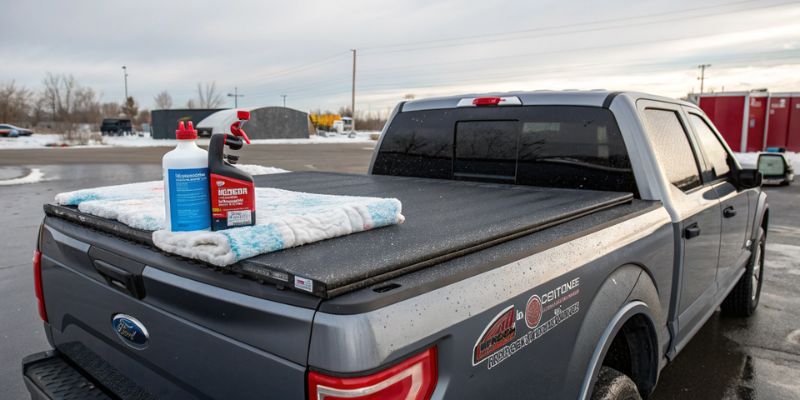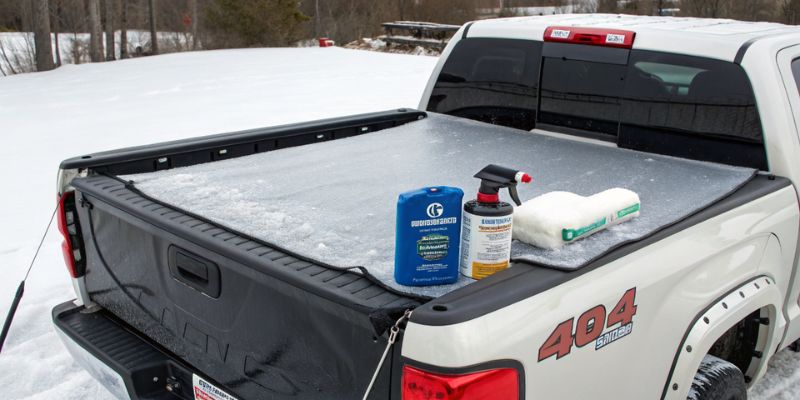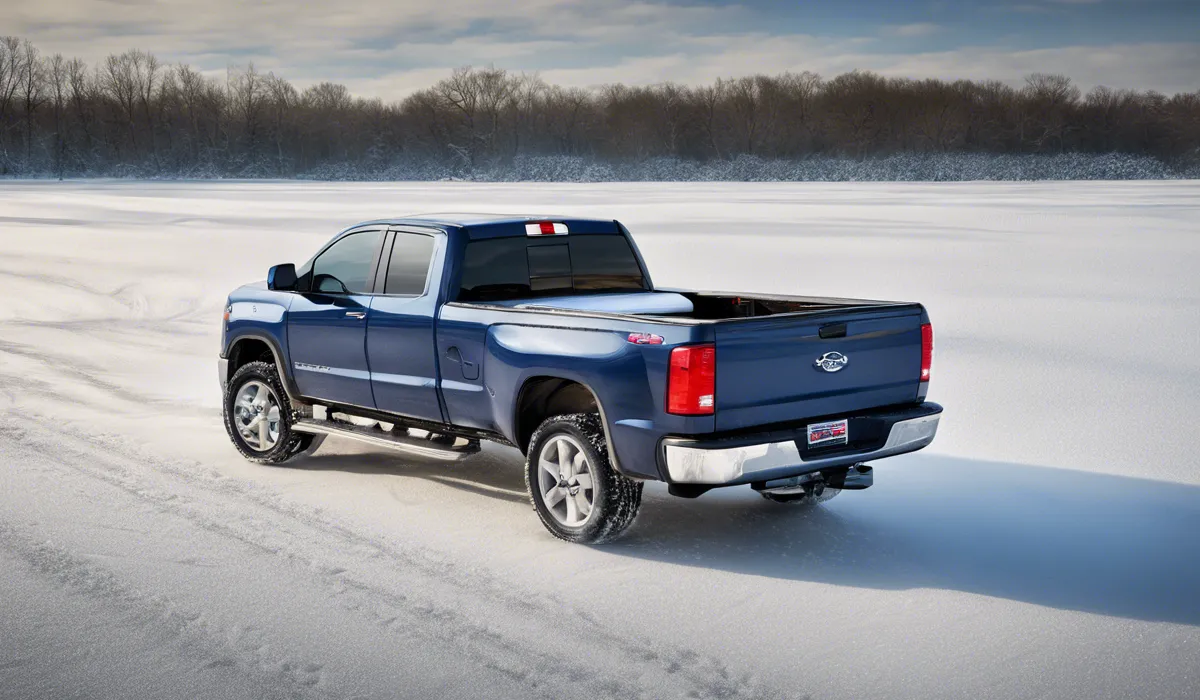To prevent a tonneau cover from freezing, apply silicone spray to the cover’s seals regularly. Ensure it’s clean and dry before closing. Park under cover when possible to reduce exposure to moisture and freezing temperatures. Use a soft brush to remove snow and ice gently.
Preventative Measures Before Freezing Weather

Apply Protective Coatings
To safeguard your tonneau cover against harsh winter conditions, applying a protective coating is essential.
The two most common types of coatings include vinyl protectant and rubber conditioner.
These products not only shield the cover from the elements but also maintain its flexibility, which is crucial in preventing cracks and tears in freezing temperatures.
When applying these coatings, ensure that the cover is clean and dry.
Use a soft cloth to spread the protectant evenly, focusing on areas that are most exposed to the weather.
For best results, apply the coating every one to three months, depending on your local climate and the manufacturer’s recommendations.
Regular Cleaning and Maintenance
Regular cleaning and maintenance are critical to prevent your tonneau cover from sticking or freezing shut.
Dirt, leaves, and other debris can retain moisture, which may freeze and cause the cover to adhere to the truck bed.
To avoid this, clean your cover with mild soap and water, using a soft brush or sponge to gently remove any accumulated dirt.
Different materials require unique care; for instance, soft vinyl covers may need a specialized cleaner to prevent damage.
Whichever material your tonneau cover is made from, ensure it’s completely dry before closing it to avoid trapping moisture.
Covering the Tonneau Cover
An additional layer of protection can be achieved by covering the tonneau cover itself.
Options like waterproof tarps or thick blankets can provide extra insulation, helping to prevent the cover from freezing.
These coverings can be secured with bungee cords or weights to ensure they stay in place during windy conditions.
The benefit of adding insulation is twofold; it not only reduces the risk of the cover freezing but also protects the cargo beneath.
By maintaining higher temperatures within the truck bed, it’s less likely that ice will form on the cover’s surface.
During Freezing Conditions

Parking Strategies
Where you park your vehicle can significantly impact how your tonneau cover fares in freezing weather.
Whenever possible, opt for sheltered parking options like a garage or carport.
These structures provide a barrier against the elements, reducing the accumulation of snow and ice.
In the absence of a permanent structure, a portable car cover can offer a similar level of protection.
Be sure to select a cover designed for winter weather, which will be more effective at insulating your vehicle against the cold.
Periodic Inspection and Manual Operation
During periods of freezing weather, it’s important to periodically check your tonneau cover for signs of ice buildup.
If ice is present, gently remove it using a soft brush; avoid using sharp tools that could damage the cover.
Occasionally opening and closing the cover can also prevent it from sticking.
Perform this action gently to avoid damaging any frozen components.
Use of Substances to Prevent Freezing
Certain de-icing chemicals are safe to use on tonneau covers and can be applied before a freeze to prevent ice from bonding to the surface.
These products should be used according to the manufacturer’s instructions to avoid damaging the cover.
For a homemade solution, a mixture of vinegar and water can also be effective.
Simply spray the solution onto the cover before the temperature drops to deter ice formation.
Post-Freezing Care and Thawing

Thawing Techniques
Once the weather warms up, you’ll need to safely thaw your tonneau cover.
Gradual thawing methods are generally safer than rapid thawing as they minimize the risk of damaging the cover.
Allow the sun to naturally warm the cover, or pour warm water over frozen areas to gently melt the ice.
For a faster approach, a hairdryer can be used with caution.
Keep the hairdryer on a low setting and continuously move it to avoid overheating any one area of the cover.
Addressing Frozen Components
Frozen locks and latches can be a challenge.
Apply a lock de-icer or a small amount of hand sanitizer, which contains alcohol, to thaw them.
After thawing, lubricate these components to ensure smooth operation in the future.
Assessing and Repairing Damage
After a freeze, inspect your tonneau cover for common issues such as cracked vinyl or warped panels.
Small cracks can sometimes be repaired with a vinyl repair kit, while more significant damage may require professional assistance.
If you’re considering upgrades or replacements, researching the right size bolts for toilet flange or the ideal size hole saw for ceiling box may lead you to find related accessories that can enhance the durability and functionality of your tonneau cover for future seasons.
FAQs About Preventing Tonneau Cover Freezing
How can I prevent my tonneau cover from freezing shut?
Prevent your tonneau cover from freezing shut by regularly applying silicone spray to the seals, ensuring it is clean and dry before closing, and parking under cover to minimize exposure to moisture and freezing conditions.
What should I apply to the tonneau cover seals to stop them from freezing?
Apply a silicone-based spray to the tonneau cover seals to prevent them from freezing.
Should I remove snow and ice from my tonneau cover, and how?
Yes, gently remove snow and ice from your tonneau cover using a soft brush to avoid damage and prevent freezing.
Is it necessary to park my vehicle under cover to protect the tonneau cover from freezing?
While not always necessary, parking under cover can significantly reduce the risk of your tonneau cover freezing by limiting exposure to moisture and cold temperatures.
What is the best way to ensure my tonneau cover doesn’t freeze after cleaning?
After cleaning, make sure the tonneau cover is completely dry before closing it to reduce the risk of freezing.
Final Thoughts
Maintaining a tonneau cover’s flexibility in cold weather involves regular application of silicone spray to the seals, ensuring it is clean and dry before closure.
Parking undercover helps mitigate freezing risks.
In case of snow or ice accumulation, a soft brush should be used for gentle removal.
